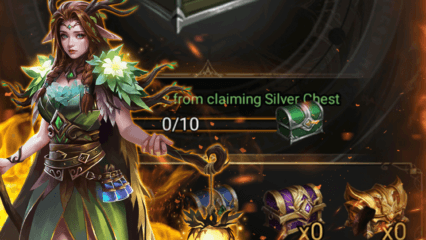Idle Dangers Beginner’s Guide – Understanding the Basics

Idle Dangers is a classic idle RPG where most of the gameplay unfolds automatically. Characters handle combat on their own while players manage progression and upgrades between fights. You’ll step into a dark fantasy world filled with non-stop waves of enemies, with your team grinding it out even while you’re not watching.
This guide is designed to walk you through the essential mechanics of the game. From the core gameplay loop to hero upgrades and the chest system, here’s everything you need to know to get comfortable with how Idle Dangers works.
The Core Gameplay Loop
At the heart of Idle Dangers is automated combat. Your team of heroes fights enemies in a continuous loop, collecting rewards as they clear each wave. There’s no need to control movement or basic attacks—everything happens on its own.

However, if you want to speed things up, you can repeatedly click or tap the screen. This increases your characters’ attack speed, helping push through harder waves when the idle pace isn’t cutting it. This small bit of interaction adds a manual layer to the otherwise hands-off design.
Earning and Using Gold
Gold is the most common resource and plays a key role in strengthening your heroes. You earn it by defeating enemies, completing tasks, and collecting from patrols.

You can use gold to level up your characters, which increases their base stats and combat effectiveness. This is your main upgrade path early on and directly impacts how quickly you move through stages.
Gear and Enhancement Stones
In addition to leveling up heroes, you can also upgrade their equipment. Each character has their own set of gear—helmet, armor, weapon, and boots—and each one boosts a different stat:
- Helm: HP%
- Armor: DEF%
- Weapon: ATK%
- Boots: HP%

Upgrading gear requires enhancement stones, which you’ll pick up through story missions, tasks, and the in-game shop. Since each hero’s gear is upgraded separately, it’s best to focus your materials on the characters you actively use.
The Chest System
Chests are a big part of the reward structure in Idle Dangers. You can earn them by clearing missions or completing daily and weekly tasks. There are five types of chests in total:
- Oak Chest: Contains 1 item; usually gold, with a small chance at purple hero shards.
- Silver Chest: Contains 2 items; mostly enhancement stones with chances at hero shards.
- Gold Chest: Contains 3 items; includes advancement stones and multiple hero shard tiers.
- Dark Gold Chest: Contains 4 items; always includes a hero shard with better odds at rare types, plus advancement stones.
- Diamond Chest: Contains 5 items; guaranteed high-tier hero shard and premium currency.

Each chest also contributes to your “chest points” bar when opened. For example, Oak gives 1 point, Silver gives 10, Gold gives 20, Dark Gold gives 50, and Diamond doesn’t give points. Filling the bar nets you a bonus chest, making even low-tier chest openings worthwhile.
Chest Drop Breakdown
Here’s a quick look at the drop rates and item counts per chest type:
- Oak Chest: 1 item — 95% Gold, 5% Purple Hero Shards
- Silver Chest: 2 items — 90% Enhancement Stones, 7% Purple, 3% Yellow Shards
- Gold Chest: 3 items — 80% Advancement Stones, 10% Purple, 7% Yellow, 3% Red Shards
- Dark Gold Chest: 4 items — 1 Hero Shard (60% Purple, 30% Yellow, 10% Red) + 3 packs of Advancement Stones
- Diamond Chest: 5 items — 1 Hero Shard (66% Yellow, 34% Red) + 4 Diamond drops

Chests are important as they are the source of many of your hero shards and valuable upgrade materials. While you will receive them mainly from completing missions and progressing in the story, you might also be able to score free chests via Idle Dangers redeem codes.
Tasks and Daily Progression
On the battle screen, you’ll notice a task list in the lower-left corner. These function as your primary missions, guiding you toward objectives and rewarding you for progress. Think of them like main quests—just tap to claim once completed.

More importantly, Idle Dangers has daily and weekly task systems that refresh automatically. Daily tasks are usually simple and fast to complete, while weekly ones take longer but give better rewards. These systems offer steady progression and help break up the repetitive idle grind.
Unlocking Patrols
Patrols unlock once you clear stage 25, introducing Idle Dangers’ built-in offline farming system. After this feature becomes available, your team will automatically continue battling and collecting resources even while you’re not playing. This allows for a steady stream of progression without needing to stay logged in all the time.
By default, the patrol timer maxes out at four hours. This means once your team has been grinding for that long, they’ll stop generating new rewards until you manually collect what’s been earned. To do this, you need to head over to the Patrol menu and claim your haul. Failing to do so means you’re missing out on valuable idle time.

Rewards from patrols include gold, enhancement stones, and advancement stones—items that are essential for hero development and gear upgrades. It’s a simple yet effective way to keep earning, even during breaks from active gameplay.
That wraps up the beginner mechanics in Idle Dangers. Once you’re familiar with how everything flows, you’ll be ready to tackle tougher content and optimize your progression. And if you’re looking to enjoy the game with better performance and controls, don’t forget you can play Idle Dangers on PC with BlueStacks.
















